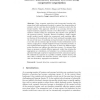Free Online Productivity Tools
i2Speak
i2Symbol
i2OCR
iTex2Img
iWeb2Print
iWeb2Shot
i2Type
iPdf2Split
iPdf2Merge
i2Bopomofo
i2Arabic
i2Style
i2Image
i2PDF
iLatex2Rtf
Sci2ools
GAMESEC
2010
2010
Effective Multimodel Anomaly Detection Using Cooperative Negotiation
Abstract. Many computer protection tools incorporate learning techniques that build mathematical models to capture the characteristics of system's activity and then check whether live system's activity fits the learned models. This approach, referred to as anomaly detection, has enjoyed immense popularity because of its effectiveness at recognizing unknown attacks (under the assumption that attacks cause glitches in the protected system). Typically, instead of building a single complex model, smaller, partial models are constructed, each capturing different features of the monitored activity. Such multimodel paradigm raises the non-trivial issue of combining each partial model to decide whether or not the activity contains signs of attacks. Various mechanisms can be chosen, ranging from a simple weighted average to Bayesian networks, or more sophisticated strategies. In this paper we show how different aggregation functions can influence the detection accuracy. To mitigate th...
| Added | 11 Feb 2011 |
| Updated | 11 Feb 2011 |
| Type | Journal |
| Year | 2010 |
| Where | GAMESEC |
| Authors | Alberto Volpatto, Federico Maggi, Stefano Zanero |
Comments (0)

